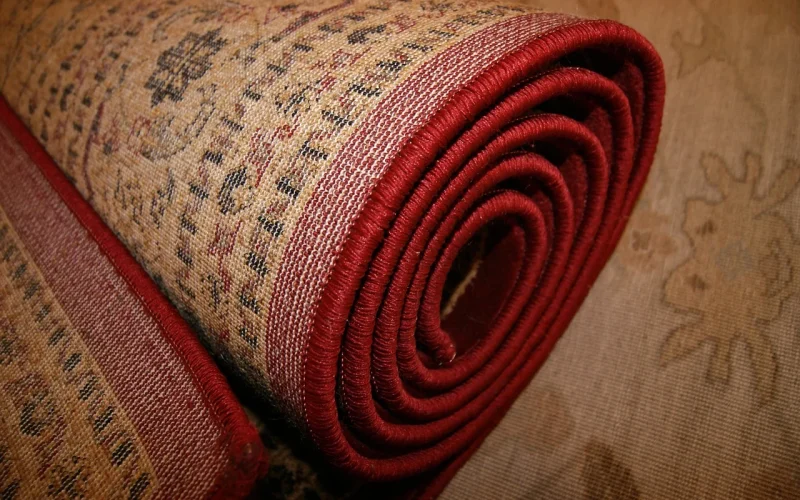If you’re new to rug shopping, all the many types of rugs available and the hefty price tags connected to many of them can easily overwhelm you.
Style, placement, and money are the three most important factors when choosing a rug.
Other considerations include how easy the rug is to clean, how long you plan to keep it, and whether you prefer particular materials.
A rug is unquestionably an essential part of any home’s décor scheme. Rugs can draw attention to a specific space area, protect flooring, cushion footfall, or provide a comfortable spot to sit or relax.
On the other hand, choosing a new rug might be complex, and you could be perplexed by the sheer quantity of materials, styles, and designs available.
However, this helpful guide aims to clear the air and make deciding on the correct rug easier.
1. Wool Rug
Wool is one of the most popular materials used in carpeting, and wool rugs are sought after for their ability to add warmth and coziness to a space.
These rugs are also environmentally beneficial and sustainable because they are collected from sheep during the summer and grow naturally.
New Zealand and Australia produce some of the highest-quality wool to make beautiful carpets.
Wool rugs are long-lasting and, depending on how they are created, can endure up to 60 years. The fibers are incredibly robust when pushed or stretched, preserving their shape.
Furthermore, the natural lanolin that coats the surface of the strands makes them stain and water-resistant. Wool is also safe to use in houses because of its fire-resistant characteristics.
Overall, a wool rug is a great floor covering that is attractive and comfortable to walk and sit on.
2. Silk Rug
Silk is one of the different rugs used to make some of the most opulent carpets, such as Persian and Oriental rugs.
Silk’s smooth texture and lovely shine make it suitable for creating wonderful ornamental pieces and works of art.
Silk rugs generally have a lower density than wool, requiring more knots per square inch and longer to complete.
However, Silk carpets are famed for their exquisite designs, and because the natural fiber keeps dye well, the colors fade gracefully with time.
Silk rugs are as gorgeous as they are delicate, and if mishandled or stored improperly, they can soon lose their shape.
It should be no surprise that silk carpets are substantial investments with hefty price tags if you want one. They also necessitate expert cleaning and upkeep, which adds to the price.
Silk rugs are best kept in your private study or as a statement piece on a wall because they are unsuitable for high-traffic areas.
3. Cotton Rug
Cotton is one of the low-cost, fun, different types of rug materials that can substitute for more expensive carpets made of wool or silk.
This is one of the different types of rugs that fades rapidly and doesn’t withstand stains. However, cotton rugs are a good choice if you’re looking for low-maintenance and easy-to-clean carpets.
Cotton rugs require only regular vacuuming and are machine washable, making stain removal a breeze. Depending on how well you care for them, you may expect your cotton rug to last a few years.
Nevertheless, it will exhibit wear and tear considerably sooner than a rug made of a more durable material like wool.
4. Natural Grasses
Grass rugs are constructed from fast-growing plant fibers and are environmentally friendly. Jute, bamboo, sisal, hemp, and seagrass are popular choices.
Grass rugs are popular because of their warm, neutral appearance, and they add a rustic, casual feel to any room.
Depending on the design, they may be utilized in any space with much foot traffic, but they shine on porches and patios.
They’re also one of the most straightforward rugs to clean, requiring only a little shake or vacuuming to remove dust and grime. However, because the cloth absorbs spills, you must be quick when blotting liquid spills to avoid permanent stains.
However, the disadvantage of grass carpets is that they can be harsh and offer little padding, making them unsuitable for lengthy periods of sitting.
5. Animal Hides
Sheepskin and cowhide are natural materials produced as a by-product of the food industry.
However, to remove any odor and prevent the hair or fur from shedding, the skins are treated with a curing and tanning process similar to that used to make leather.
Rugs manufactured from animal skin may not appeal to everyone ethically, but others may argue that repurposing the skins into rugs is a lesser evil than discarding them.
Animal skin rugs are durable in high-traffic locations, but you’ll probably need a big room or wall space to showcase them to their full potential.
A cowhide rug will surely be the center of attention in any room when shown in its full size and natural shape.
Faux skins made of synthetic materials such as plastics or nylon may be the solution for consumers who prefer the look of animal skin carpets but want a more ethical option.
However, the disadvantage of rugs is that they don’t feel as authentic as the actual thing and don’t last as long.
6. Synthetic Rug
Synthetic rugs are synthetic fibers that don’t feel fake or plasticky. Many synthetic fibers resemble natural materials in appearance and feel, and semi-synthetic fibers are made by extracting cellulose from plants.
Polypropylene, microfiber, polyester, viscose, and nylon are common synthetic rug materials.
However, rugs made of synthetic materials lack the same strength and durability as natural materials. Still, they make up for it in terms of cost, design variety, and simplicity of maintenance.
They keep their color well, and some are designed to be stain, moisture, and insect-resistant.
7. Hand-Knotted Rug
Hand-knotting is the most time-consuming and expensive method of rug-making. It’s one of the oldest rug-making techniques, dating back over 2000 years.
This method can take a few months to several years to complete. Hand-knitting requires the use of a loom, a specially built machine.
Vertical threads, known as warps, are tied to the loom before being intertwined with horizontal threads, known as wefts.
Afterward, a carpet weaver weaves yarn around the warp thread, tightens it to form the knot, and cuts off the extra string. The carpet pile is created by the knots.
8. Hand-Tufted Rug
Tufted carpets are one type of rug made with a small gun known as a ‘tufting gun.’
They use a completely different weaving process by pounding strands of silk or wool on a textile canvas stretched over a metallic frame. Some people mistake tufted carpets for hand-knotted carpets at first glance.
Look at the back of the carpet to tell the difference between hand-knotted and tufted carpets.
Unlike hand-knotted rugs, Tufted rugs have a white latex canvas back with no evidence of wool knots.
9. Hand-Woven Rugs
Hand-woven rugs, like hand-knotted rugs, are produced on a loom using the same interweaving warp and weft threads.
Knots are not made; therefore, there is no pile, and the rugs lie flat on the ground, earning them the nickname flatweave rugs.
In addition, hand-woven carpets are frequently reversible since the weaving can usually be seen on both sides. Machine-made flatweave rugs are also available.
10. Machine-Made Rug
This is one of the different types of rugs made on massive power looms that produce hundreds of daily rugs. It takes less time and effort than hand-knotted carpets, and the rugs are less expensive.
The machine-knotting method is similar to the hand-knotting approach but substantially faster. On a power loom, you can make rugs with or without piling.
11. Hooked Rug
Hooked rugs are one of the different rugs that use the same looping process as tufted carpets.
The main difference between the two is that in a hooked rug, the loops on the face are left intact rather than being chopped off to make a flat pile, as in tufting.
12. Braided Rug
Connecting pieces make braided rugs from strips of cloth. Fabrics ranging from cotton to wool may be used, and their thicknesses may differ.
Do you want to know what kind of decor they can match? They are, after all, ideal for both rustic and classic house décor.
Braided carpets also have the benefit of being reversible. However, if one side of the rug becomes dirty, the other can be used. They’re also available in oval and circular shapes and various sizes.
13. Flatweave Rug
Kilim rugs and Dhurrie carpets are the same. Because flatweave rugs have no pile, they do not shed. They are woven on a loom rather than hand-knotted.
Weaving is done by weaving warp (length) and weft (width) threads together. The rug is fragile and elegant, thanks to this weaving technique.
Wool is the most essential and primary material to make a flat weave rug.
Wool is used for the warps and wefts in most flatweaves or both, and wool is the necessary weft material used with cotton warps. The other material used instead of wool is art silk.








